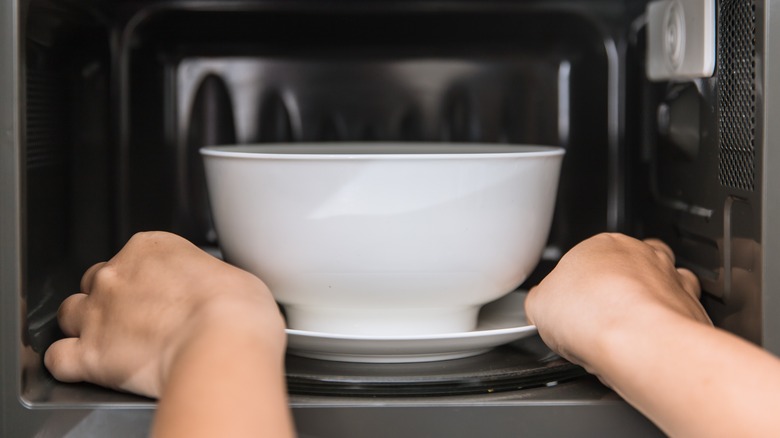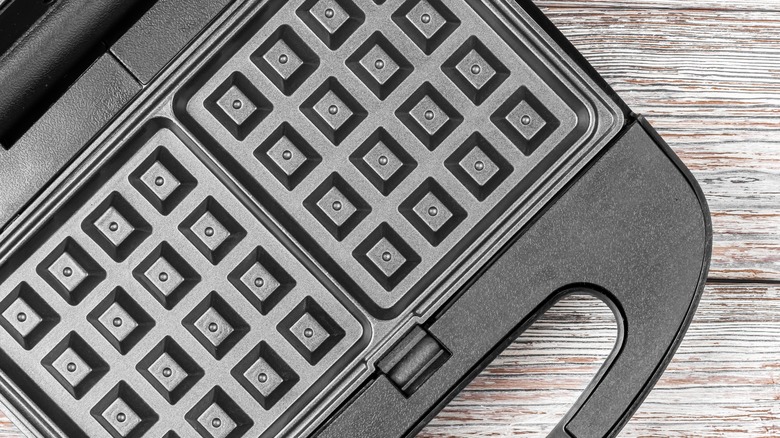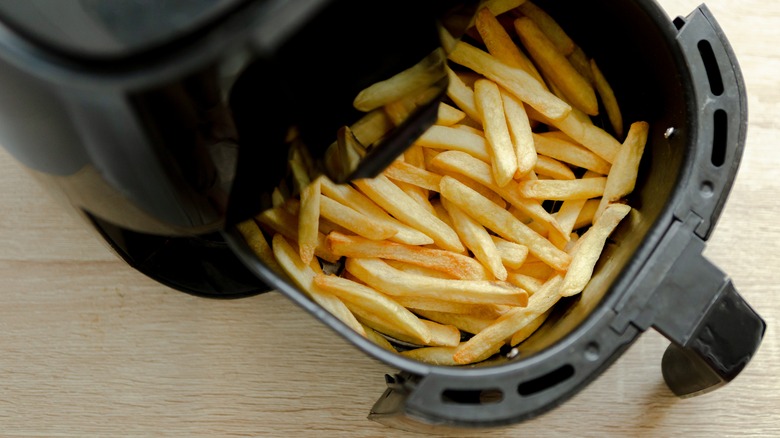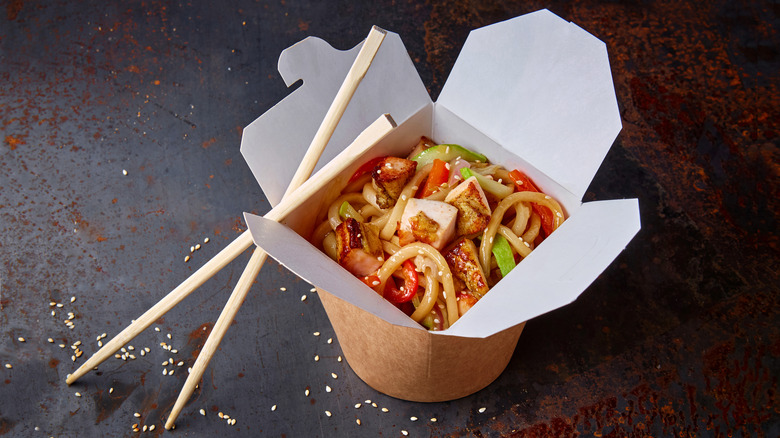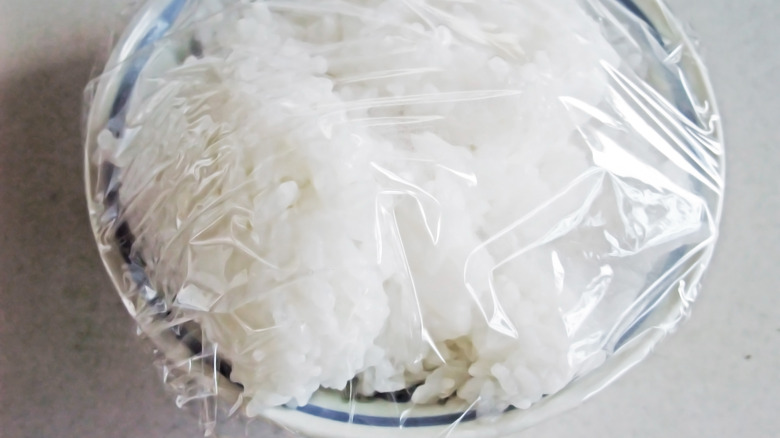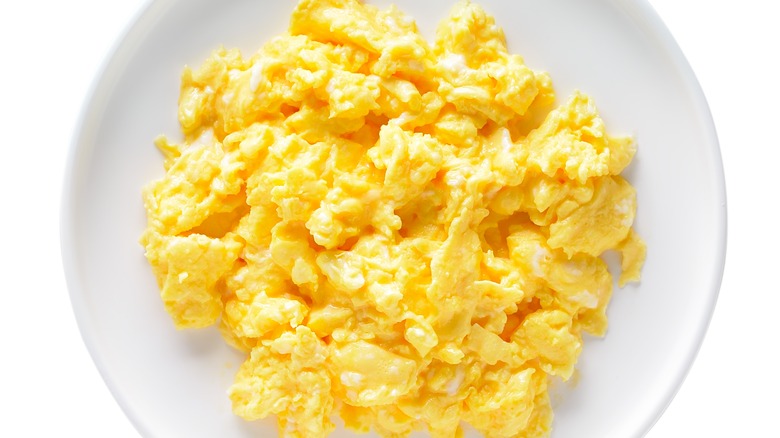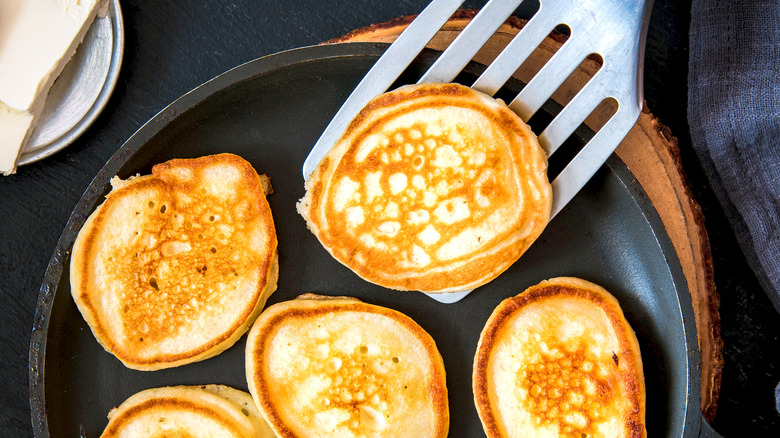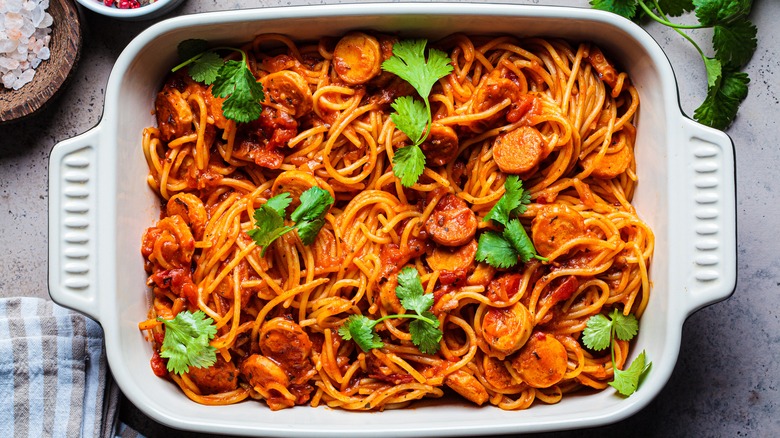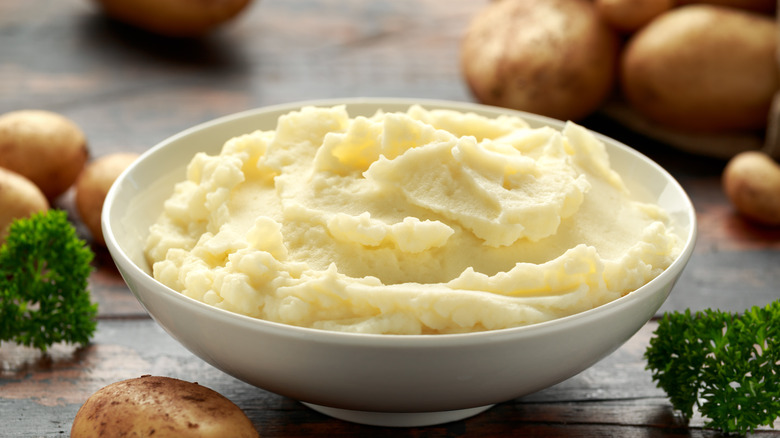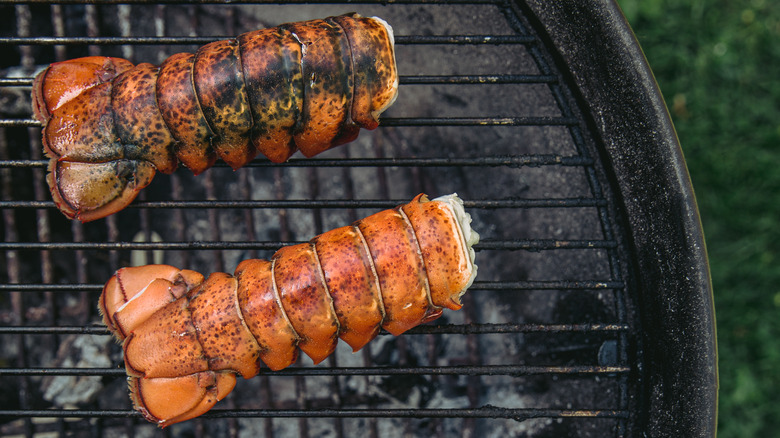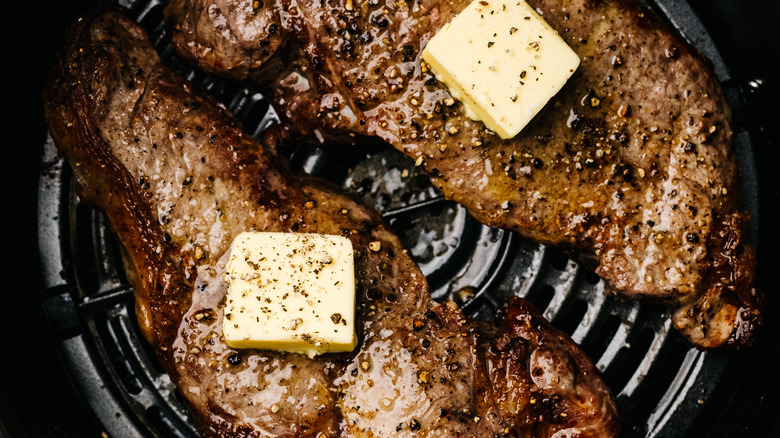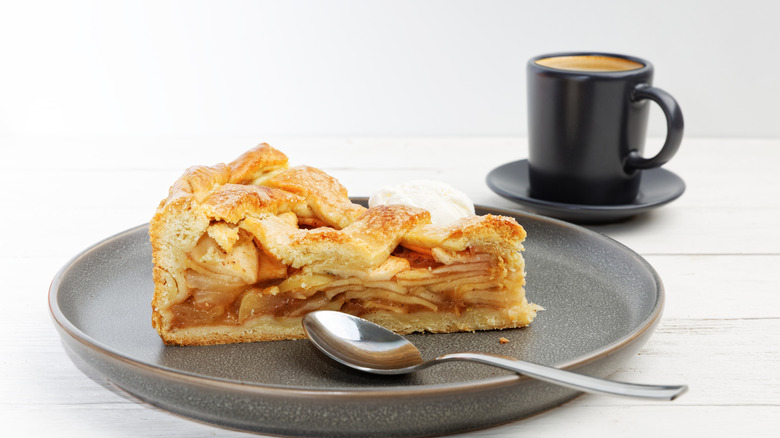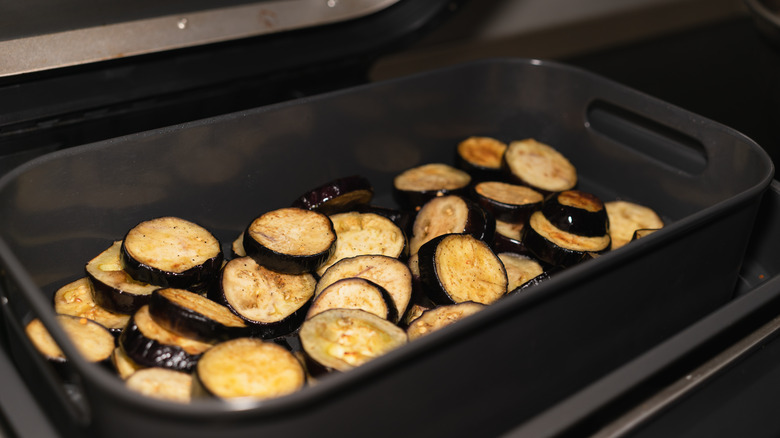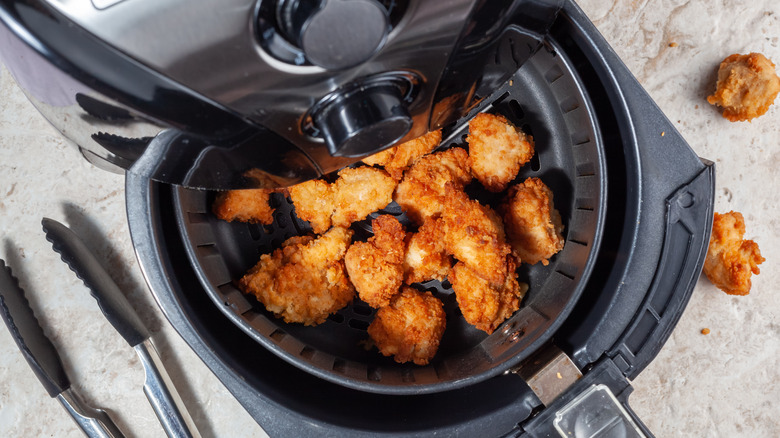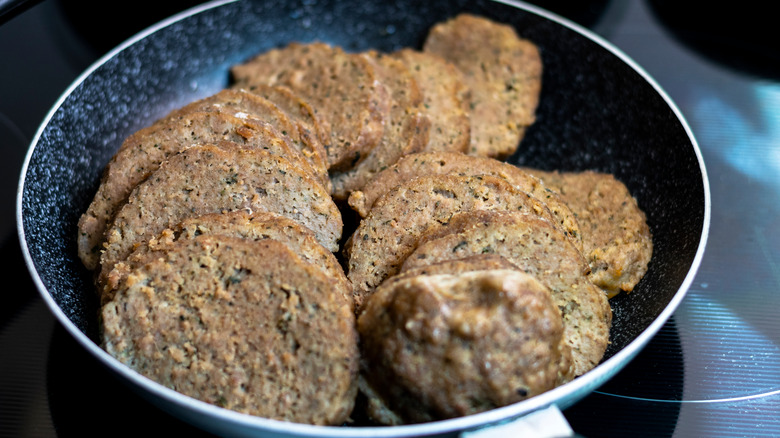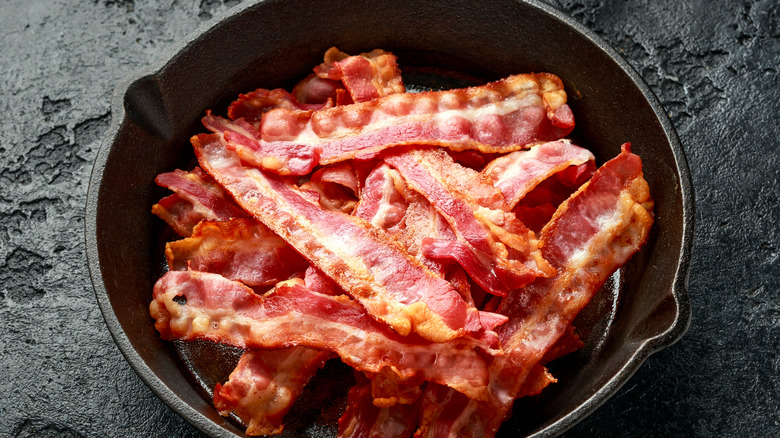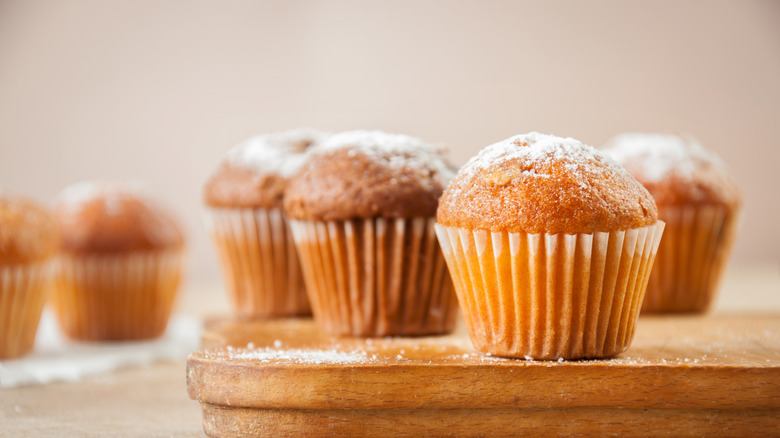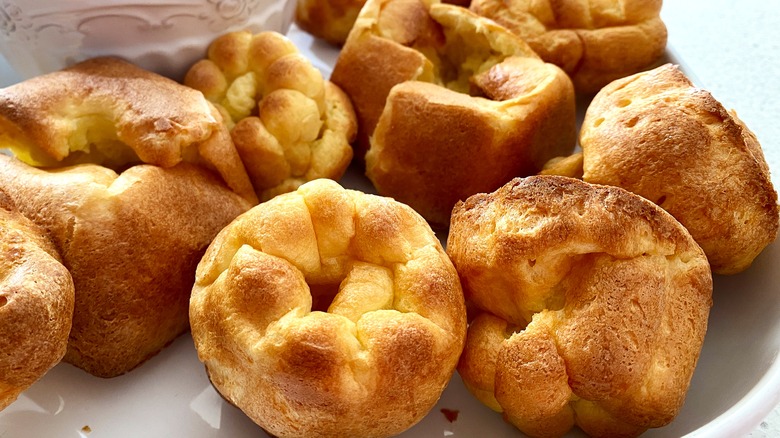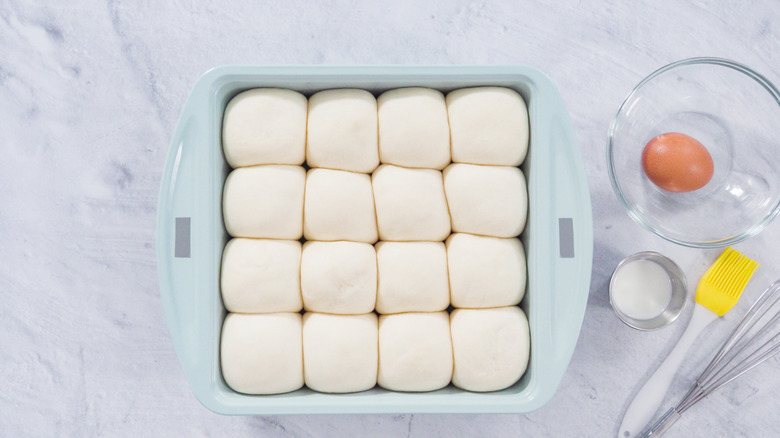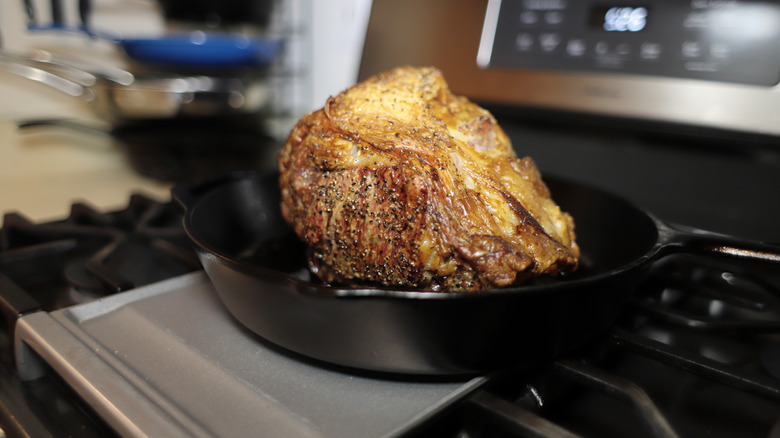19 Ways To Reheat Foods To Perfection
Finding out how to make your leftovers taste the same on day two is an exact and difficult science. If the food comes out of your microwave soggy or with a texture akin to corrugated cardboard, something might need to be fixed with either your storage or cooking method.
Using the wrong kitchen appliance is one of the biggest mistakes everyone makes when reheating food. Many folks will use their microwave as a catch-all, but doing so might be detrimental to your meal's taste and texture. Instead, the best and most ubitiquous policy for nuking your leftovers is to try to reheat them with the same appliance you prepared them with in the first place. But is that true for all foods? We're here to investigate how to warm up leftovers to preserve their texture and taste. You might not even remember they're a day or two old after you finish!
Use a waffle iron or pan to avoid soggy pizza
Soggy, day-old pizza is very late-night-college-dorm-room for us. But with the right reheating method, it'll be as if you just had it delivered post-degree. If you use an oven of any sort, you risk drying out the food, so instead, try a waffle iron. Stack two slices on top of one another and add them to the appliance after spraying the surface with cooking oil. Close the waffle iron for a few minutes, rotating the pieces once or twice to ensure that the pie's nooks and crannies are thoroughly heated.
Thinner pizza has a better track record with this hack because it will result in better heat distribution. However, if you don't want to use a waffle iron or your pie is more of a thick-crust variety, we recommend using a skillet. Place a slice or two in the pan and cook on medium-high for about six minutes.
Air-fry your French fries for crispy results
You should reheat fries with either a shallow fry or an air fryer. While the former will give your potatoes the most similar texture to the day you purchased them, it will require a lot of cleanup. Despite this, if you choose this cooking method, you should heat the fries at 300 degrees Fahrenheit for about five minutes in neutral oil for the best results.
However, the air-fryer is a better alternative to warming up this side dish because it uses less oil and produces less mess. It is also as fast as a microwave, but it won't make your fries soggy after you use it. Heat your air fryer to 350 degrees Fahrenheit and cook for five minutes. An extra spritz of oil before heating can help improve the crispness too.
Use a wok to reheat Chinese takeout
Everyone loves Chinese takeout — until you have to warm it up the next day, and it comes out of the microwave soggy and flavorless. If you want to capture the straight-from-the-wok essence of dishes like lo mein and stir fry, we recommend using a hot wok or skillet. These are the best ways to reheat Chinese food because you can taste test the meal as you cook and season it to your liking. You can also monitor the crispiness or softness and include more broth or oil as needed.
To reheat your dish, warm up your wok to medium heat and add a couple of tablespoons of broth or oil. The liquid will prevent the ingredients from sticking to one another. Add your Chinese food to the pan, tossing or stirring occasionally.
Use the stovetop or oven to reheat rice
Rice is notoriously tricky to reheat because it is quick to dry out. However, you can't go wrong with using the oven or the stovetop to warm up this food. You won't have to worry about the finicky hot spots of your microwave, nor will you worry about rotating and tossing your grains mid-cook.
If you use the stovetop, add two tablespoons of water for each cup of cooked rice you need to heat up in the pan and cover with a lid. If the rice seems to be drying out, add more water. The oven method takes longer and doesn't give you the luxury of watching and adding water as needed, but it is still more consistent than the microwave. Just add the same water-to-rice ratio and cook between 350 and 375 degrees Fahrenheit, covered with aluminum foil.
Make a mock sous vide to reheat scrambled eggs
Who wants to eat day-old scrambled eggs — especially when making a fresh plate is so easy? But, if you happen to run out of fresh farm eggs and leftovers are all you have to work with, reheating them may seem simple enough. However, getting the perfect texture — not so much. Gentle heat exposure will cause the food to get rubbery and inedible, so instead, you'll need to expose it to a quick burst of heat.
Rather than using a microwave or a stovetop, try a mock sous vide using a resealable freezer-safe Ziploc and a water bath. First, fill the vessel with warm water. Then, rest your air-tight bag of eggs in the container for about five to ten minutes.
Skip the microwave for pancakes
If you make breakfast for a crowd, you'll likely have some leftover pancakes. We've found that using your toaster oven is the best way to reheat this breakfast staple. This appliance supersedes the microwave and traditional oven because it locks in moisture and prevents the griddle cakes from turning into piles of mush or becoming too crunchy. Also, if your pancakes are thin, you won't need to defrost them before popping them into your toaster; this allows their edges to crisp up, resulting in a firm yet moist flapjack.
If you're preparing hotcakes for a crowd and don't mind spending a little extra time prepping, place them on a lined baking sheet, cover them with aluminum foil, and bake at 350 degrees Fahrenheit for about five to ten minutes.
Stick to the oven or stovetop for pasta
Noodles are already soft, so warming them up in a microwave can easily take your dish from a delicate Alfredo to a pile of mush. The best way to reheat pasta without sauce is to add them to a colander and dunk the vessel into a pot of boiling water for less than a minute. This process will allow your noodles to perk up without getting soggy. If you've already combined the sauce and pasta, use your oven to bring it to temperature instead. Add a splash of water to oven-safe bakeware and tent to prevent the dish from drying out, especially for meals like lasagna or baked ziti.
You can also use your stovetop to reheat your food if you're working with a creamy sauce. Simmer the pasta over medium-high heat for two to five minutes, occasionally tossing, to keep it from sticking. Add extra meat or vegetables with this method to transform your leftover dish into a novel meal idea.
Trust your microwave for mashed potatoes
A microwave isn't out of the question for all foods. One of the best ways to reheat mashed potatoes is to cook them in the appliance at half-power for short intervals. Although this directive might seem excessive, it is crucial because it prevents the starches in the dish from gelatinizing and becoming gummy.
Once your food is sealed with plastic wrap, you can put it in the microwave for a minute. To counteract the hot spots in your appliance, stir your mashed potatoes after each cooking interval. Adding a splash of milk or cream will also create a better texture and impart more flavor to your spuds. Once the side dish is warm, pour over your favorite gravy and dig in!
Give lobster a second day with your oven or grill
Despite its history, lobster is now one of the most expensive types of seafood you can purchase — and it's why you should savor any leftovers you can. The best ways to reheat the crustacean and save its texture and flavor include using your oven or grill.
If you're working with whole lobsters or tails, place them in foil, belly-side-up, and add a pat of butter on top. This keeps the meat moist and imparts a desirable flavor. Next, bake the seafood on a sheet pan for five to ten minutes at 350 degrees Fahrenheit.
If you want to transform the texture of your crustacean, pull out the charcoal and light your grill. Place the lobster belly-side down over high heat to infuse a smokey yet bright flavor. Since the fire can be harsh on the meat, you should continuously douse the shell in butter or oil and seasonings.
If you're on a time crunch, reheat steak in the air fryer
Reheating a thick porterhouse or New York strip can seem daunting. One of the ways you can reheat steak without sacrificing a ton of time or kitchen utensils is by using your air fryer. The circulating heat from the appliance will heat both sides of the meat simultaneously, making it less prone to overcooking. If you use your oven or microwave instead, you risk drying it out.
Start by preheating your air fryer to 380 degrees Fahrenheit and brushing your steak with a thin oil coating. Once the meat is in the air-fryer, flip it every two to three minutes until the internal temperature, at the thickest part of the cut, reads at least 110 degrees Fahrenheit.
Ovens and toaster ovens will make your pie taste freshly baked
If you like to eat your apple pie fresh out of the oven, you'll want to read more about this hack. Using your stove to heat a whole or a single slice of the pastry is always a good option. Most pieces will be warm but not soggy within 15 minutes at 350 degrees Fahrenheit. If you're in a time crunch, you can also use your air fryer to warm up a slice of pie. Begin by wrapping it in aluminum foil and cooking it at 325 to 350 degrees Fahrenheit for five to seven minutes.
Using your microwave won't do you any favors — except saving a few minutes. The steam from the baked good will make the crust soggy rather than crisp and brown. If you aren't partial to a good crust, you can nuke a piece at thirty-second intervals until the pie is warm.
Air-fry or oven-bake roasted vegetables
There's nothing like the taste of roasted (or, even better, grilled) vegetables in the summer. But many things are better than a sad, mushy plate of cooked veggies you just reheated in the microwave. We should also note that produce with a high water content, like squash and eggplant, tend not to crisp up as well on the second day as those like broccoli or bell peppers. If you want the crispiness of roasted vegetables to shine, you need to invest a little time and preparation into them.
The first way to bring new life to your day-old veggies is to cook them on a sheet pan in your oven. At 400 degrees Fahrenheit, most produce will crisp up in around five minutes. If you use your air-fryer, you won't have to wait for your appliance to preheat. This method also takes slightly less time, around three to four minutes.
Use your air-fryer for fresh fried chicken
The best part about fried chicken is the crispy, crunchy exterior. And unfortunately, you won't get that same texture from your skillet or microwave.
If you want perfect, reheated fried chicken, you must shallow fry it. While this method only takes a few minutes, it isn't everyone's forte — not to mention that you'll need to clean up all of the oil afterward. The next best option is using your air fryer; you can warm up the cold protein in the basket while it's preheating rather than waiting for it to come to room temperature before shallow frying on a skillet. Once your air fryer has reached the recommended 375 degrees Fahrenheit, cook the chicken for about two minutes on each side.
Use a stovetop for crispy meatloaf slices
Leftover Sunday dinner meatloaf can either be great or a total flop. Microwaves are best suited for instantly reheating small volumes of the dish — but you won't do anything for its texture. If you want to improve the consistency of your meal, you should instead use a skillet.
Start by slicing your desired portion of meatloaf and adding a bit of oil, butter, or bacon grease to the skillet. Cook over medium heat, occasionally flipping, for a crispy sear. This gives you control over the dish's moisture; you can add a splash of water or broth to the pan to help keep it moist. Before removing your meatloaf from the cooking surface, check for an internal temperature of 165 degrees Fahrenheit.
Pull out your non-stick skillet to reheat bacon quickly
Some of the absolute best ways to reheat bacon include using a non-stick skillet. Before adding your meat, you'll need to preheat the pan over medium heat. Then, once the pieces begin to sizzle, transfer them to a paper towel-lined plate to soak up any of the excess oil.
If you want to reduce the number of dishes you need to cook your bacon — or want to cook a single piece or two, you can use your microwave. Cover the strips with a paper towel to absorb any splattering grease if you use this method. This will have the meat ready in less than a minute — but you will lose out on the crispiness, texture, and taste.
Use your oven or a skillet to transform day-old muffins
Muffins are one breakfast treat that will always taste better warm. The best method to heat these baked goods is where you first cooked them: the oven. If you start with slightly stale pastries, add a quick spritz of water to the top before baking. Next, heat them in foil at 325 degrees Fahrenheit for about ten minutes. If you're working with gigantic muffins, cut them in half beforehand to ensure they are warm throughout. For a crispy top, peel back the foil for the last few minutes of cooking.
If you want to make your pastries more buttery and crisp, try cutting them in half and placing them cut-side down on a buttered skillet. Add a little water to the pan to encourage steaming, and cover for a few minutes over medium heat.
Grab a baking sheet and use your oven to transform popovers
Popovers are a very light and notoriously finicky side pastry. They must be reheated in an oven, toaster oven, or air fryer rather than a microwave to preserve their fluffiness and prevent sogginess. If you're using the stove, you can use a popover pan, muffin tray, or standard baking sheet. While leaving the treats whole is traditional, you can also slice them in half and add your favorite cheese to the top for a quick snack. Bake the popovers for around 10 minutes between 350 and 400 degrees Fahrenheit.
If you want to avoid sogginess, you need to store them correctly in the first place. Prick the top of the baked good with a toothpick or fork to prevent the inside from becoming overly moist. Then, cool the popovers entirely before adding them to a bag or airtight container to maximize their storage life.
Try a slow cooker to keep your dinner rolls warm
A slow cooker is one of the absolute best ways to reheat dinner rolls because it can make frozen ones taste homemade and keep room-temperature rolls warm before your meal starts. To use this method, lay a damp kitchen towel across the bottom of the appliance, then place a single layer of the bread on top. Cover the rolls with another slightly wet, clean towel and heat on the low setting for about half an hour. Afterward, set the slow cooker to warm for another two hours before serving. Slather the heated baked goods with a layer of honey butter and enjoy.
If you don't have a slow cooker to spare, you can put the rolls in a baking pan, allowing the edges to touch to prevent them from getting too crispy, and bake at 350 degrees Fahrenheit for seven to ten minutes.
Stick to a slow bake for prime rib
The absolute best method for warming up prime rib is a slow, gentle reheat in your oven. This will prevent the inside from drying out and becoming too chewy and still produce a crispy finish on the outside.
Start by cooking the meat uncovered on a wire rack over a rimmed baking sheet (to capture any drippings) at 250 degrees Fahrenheit. You'll need to cook the meat until its internal temperature reads 120 degrees Fahrenheit — which should take an hour to an hour and a half. Then, remove the cut from the oven, pat the outside with a towel to remove excess moisture, and sear it on all sides in a hot, oiled skillet for a few minutes. You'll get a perfect brown sizzle outside with a tender, juicy inside.
